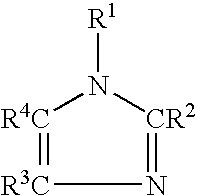Thin chip resistant powder topcoats for steel
a technology of chip-resistant topcoat and steel, which is applied in the direction of synthetic resin layered products, coatings, transportation and packaging, etc., can solve the problems of high cost of coatings that would meet the automotive oem chip-resistant coating test, the thickness of topcoats, and the steel coil springs in the wheel assembly of automobiles and other vehicles are subject to very demanding conditions, so as to achieve thinner and/or more economical topcoats
- Summary
- Abstract
- Description
- Claims
- Application Information
AI Technical Summary
Benefits of technology
Problems solved by technology
Method used
Image
Examples
examples 1a-6a
A AND B AND EXAMPLES 1A-6A
[0060]Each of basecoat and topcoat coating powders were formed from the ingredients listed in the following Table 1 according to a method wherein the raw ingredients were blended by shaking them in a plastic bag for about 1 min, then extruded for a short time (60-90sec) in a Prism Twin Screw TSE 24PC extruder set at 71.1° C. (160° F.) into sheets, which were air cooled on a belt and broken into chips. The resulting chips are mixed for about 1 minute in a plastic bag with dry flow aid in the amount indicated and then ground at high speed in a Brinkman Retsch ZM 1000 Laboratory Grinder to a powder, and then screened using an 135 μm (100 mesh) screen to remove coarse particles.
COATINGS: EXAMPLES 1-9
[0061]The resulting epoxy basecoat and topcoat powder coating compositions were then electrostatically sprayed one by one, dry on dry, with a Nordson Versa-Spray II electrostatic spray gun onto the substrates indicated in Tables 2 and 3, below, each of which were p...
example a
Basecoat Formulation
[0067]
IngredientphrDiglycidyl ether of bisphenol A epoxy resin: EEW* from 930 to92.01180Imidazole adduct of diglycidyl ether of bisphenol A epoxy resin3.0Carbon black pigment3.0Bisphenol A end capped diglycidyl ether of bisphenol A, with20.8hydroxyl equivalent weight of from 370 to 400Elemental Zinc powder250.0Araldite GT 7226 / 9808 Master Batch8.0Post-Blend (dry flow aid)%Cab-O-Sil ™ M5 fume silica0.3*EEW: Epoxy Equivalent Weight
PUM
| Property | Measurement | Unit |
|---|---|---|
| thickness | aaaaa | aaaaa |
| thickness | aaaaa | aaaaa |
| temperature | aaaaa | aaaaa |
Abstract
Description
Claims
Application Information
 Login to View More
Login to View More - R&D
- Intellectual Property
- Life Sciences
- Materials
- Tech Scout
- Unparalleled Data Quality
- Higher Quality Content
- 60% Fewer Hallucinations
Browse by: Latest US Patents, China's latest patents, Technical Efficacy Thesaurus, Application Domain, Technology Topic, Popular Technical Reports.
© 2025 PatSnap. All rights reserved.Legal|Privacy policy|Modern Slavery Act Transparency Statement|Sitemap|About US| Contact US: help@patsnap.com

